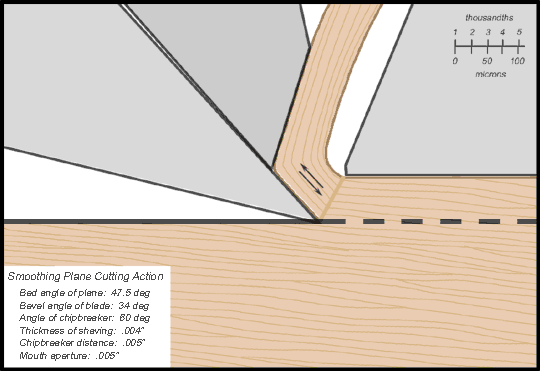|
|
|
There are different opinions about whether the top iron (or cap iron) of a smoothing plane performs the function of breaking the shaving. I believe it can break the shaving in a way that helps to reduce tear-out even when the shaving is very thin, but only if it is set extremely close to the cutting edge of the blade. I’ve recently done a test that confirms this. How close must the top iron be set to break the shaving? A professor at a Japanese university has studied the effect of chipbreakers in woodworking planes, and has taken pictures of shaving formation that show how they can be set to reduce tear-out. Depending on the angle of the edge of the chipbreaker, a distance of from .004” to .008” was most effective. For more information on this study, see the link on the Links and References page for Chutaro Kato of Yamagata University. [This link no longer worked the last time I tried it. Professor Kato’s study is reproduced here in a slightly edited version.] Here is a diagram that shows how the chipbreaker works. It is based on one of Professor Kato’s images and has been adjusted to correspond to the blade angles I am using. The thickness of the shaving has been left at .004” because a shaving that thick produced tear-out in the study, while a shaving .002” thick did not, even without a chipbreaker.
In Professor Kato’s study, there was no chipbreaking action due to the narrow mouth shown in the illustration above. I have added the narrow mouth to show how it can work in conjunction with the chipbreaker. The dimensions in the diagram are all to scale, including the lines that show the wood grain. These lines show the average size of the tracheid cells that make up most of the volume of wood. Softwood tracheid cells tend to be larger than those shown, hardwood cells on average are somewhat smaller. As the cutting edge cleaves the wood to form a shaving, there is a line where the wood is bent. At this line and at the edge of the chipbreaker, the fibers in the wood are forced to slide against each other, as shown by the pair of arrows. This shearing effect weakens the shaving and causes it to curl. The chipbreaker works by pushing back on the shaving and forcing it to bend more sharply at this shear line. The same effect can be achieved by using a higher cutting angle for the blade. This raises the question of whether a higher blade angle alone will provide all the benefits of a closely set chipbreaker. I believe it may in hardwoods, but for softwoods that lose surface clarity when worked with a high-angle plane, there may be an advantage to using the lower-angle plane with a chipbreaker. In Professor Kato’s study, he mentions deformation that results when an 80º chipbreaker edge is set .004” from the blade edge. It is this deformation that causes the cloudy look that characterizes the surface of softwood that has been planed with a high angle blade. My own experience has been that if the chipbreaker is too close to the edge, a very poor quality of surface is produced. I’ve had good results at distances as close as .005” when taking shavings up to .004” thick. This was while planing soft pine, and I don’t know yet if this result will hold for other species. The partial results of these tests can be seen on the page Chipbreaker Tests.
|
